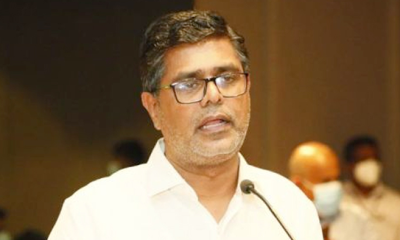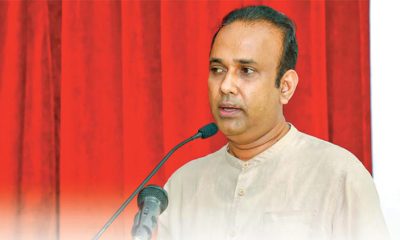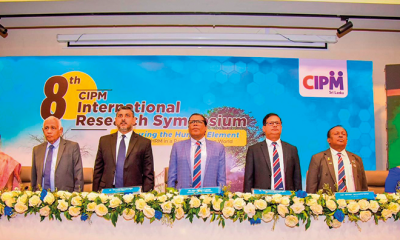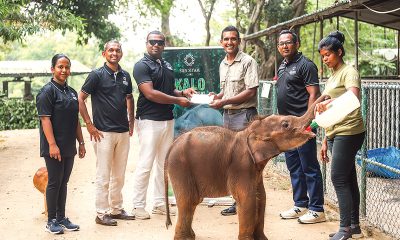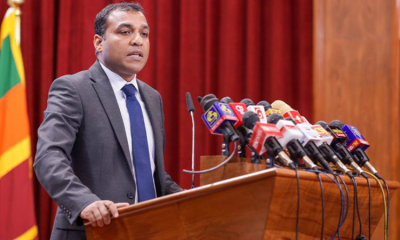Features
Fifty Years of Friendship and Solidarity
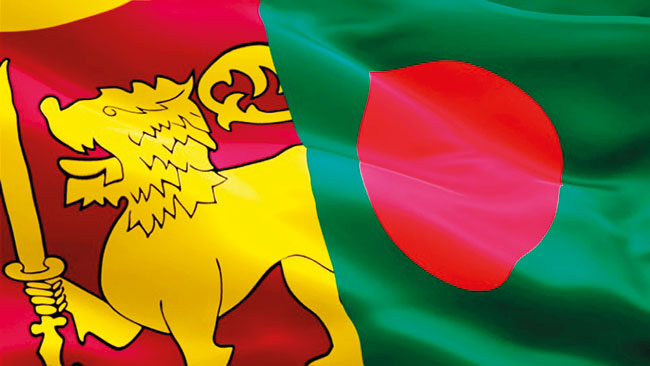
Sri Lanka–Bangladesh 50th Anniversary
Speech delivered recently by
Professor Sudharshan Seneviratne
High Commissioner for Sri Lanka in Bangladesh
Ambassador Extraordinary and Plenipotentiary to the Kingdom of Bhutan
The High Commission of Sri Lanka in Bangladesh together with its fraternal partner, the High Commission of Bangladesh in Sri Lanka are pleased to share with our well-wishers this landmark event celebrating 50 years of friendship and solidarity. As an initiative taken by our two Missions, the anniversary will be celebrated throughout this year on various topical areas ranging from investments to culture. It is expected to be a common platform reaching out to our valued communities.
Relationships between our lands go beyond 50 years of its modern-day connectivity. Vangadesha and Tambapanni are historic lands proud of their ancestry and culture dating back to C. 600 BCE. That matrix shaped and cemented our commonalities, culture and above all our shared destinies. It was nurtured within the oceanicscape of the Indian Ocean and the Bay of Bengal. Pre-modern connectivity is seen through the lens of trade exchange, religion, dance, poetry as our shared heritage. Eventually, we overcame colonial occupation culminating in the rise of independent sovereign and democratic states known as Bangladesh and Sri Lanka.
The sustainable relationship between two lands and their cultures cannot be gauged by abstract situations and simple statistics of the political-economy. It is something far more sensitive, durable and tangible. It is best seen as a symbiotic relationship reaching out to each other with respect. Our destinies, our past, present and future are essentially interdependent. In my short presentation unfolding our relationship, I will speak of past experience, present interaction and the way forward towards a shared future.
Past experience
Legend has it that around C. 6th Century BCE, a prince from Vangadesha arrived in Tambapanni and married a princess from that island. The legend is found in the Pali texts in Sri Lanka datable to c. 4th Cent. CE. The chronicled legend is a reflection of preexisting early oceanic connectivity on trade and cultural exchange between the two ends of the Bay of Bengal. The archaeological record provides far more tangible evidence from ancient material culture. It sheds light on a trading vortex based on luxury commodities such as, pearls, chank (conch shell), ivory, precious stone, metallic resources, sandalwood being some of the traded items mediated through merchants and mariners of our lands.
Intense convergence of trade in the Bay of Bengal witnessed economic and religio-cultural interactions during the Middle Historic period reaching higher levels. Buddhism was a primary medium that carried the message of culture and civilizations to both lands. It endowed a rich doctrinal knowledge of Theravada and Mahayana traditions. The historic material culture and the living traditions of Buddhism in Sri Lanka and Bangladesh reflect the pristine sentiments embedded in the cultures of these lands. Medieval texts in Sri Lanka record movements of Buddhist monks and merchants traversing the waters of the Bay of Bengal as goodwill envoys exchanging ideas, culture and commodities.
A deeper history between our two lands unfolded itself in the Colonial period. They are represented in aesthetically pleasing folk dance, folklore, poems, songs and village games embedded as an inherent part of the Sri Lankan culture. For instance, the dances representing Olinda songs and Bangalu walalu or bangles of Bengal are good examples.
Late Colonial and the rise of nationalism in the subcontinent witnessed a closer affinity with the culture of Bengal through the medium of art forms, songs, dance and education. Gurudev Rabinranath Tagore was the catalyst that forged a renaissance culture carving a permanent conduit between our lands. Rabindra sangeet and dance forms inspired the poetic expression of Sri Lankan artists such as Sunil Shanta and a host of others nurturing a permanent niche for itself within the Sri Lankan ethos.
Present Interaction
The contemporary period witnessed Sri Lanka and Bangladesh rising from multiple adverse situations. Both countries have a chequered history emerging from colonial oppression, natural disasters and terrorism. Our people rose again from ashes and destruction with greater resilience.
Today our two countries maintain a healthy relationship with each sharing common goals “for our people and the region”. We celebrate shared sentiments of mutuality over economic and cultural aspirations. Our two leaders hold each other with trust and consider each country in the highest esteem as kin-countries and as most trusted friends. We stand together at good times and take equal care of each other and ungrudgingly extending a magnanimous hand of solidarity and assistance at times of adversity.
Today we are at the threshold of entering a new era of cooperation and solidarity. The philosophy driving our engagement in Bangladesh is a two way process establishing a healthy working relationship. This philosophy is based on a symbiotic relationship of interdependence and mutual respect for each other and not one based on patron – client relationship. This synergy it fact presents itself how Bangladesh provided a conducive environment and safe haven for Sri Lankan investments and in turn how Sri Lankan professionals invested towards the growth of Bangladesh.
This mutuality evolved over some 40 odd years ago when Sri Lankan capital, expertise and technical know-how contributed towards a takeoff point in the apparel industry of Bangladesh which is now the primary provider to the world. As of now, Sri Lankan Investment amounts to around 2.5 billion US$ and some of the companies represent high-end professionals as CEO’s and middle management technocrats. They are mainly based in Dhaka and Chittagong roughly amounting to about 2000 individuals. Sri Lankan blue-chip companies cover banking, biscuits, gas, power and energy, apparel, shipping & logistics, health care, management and investment to mention a few. There are at least 25 cluster groups with 100% owned, 75% subsidiaries with controlling power around 80%. HE. Prime Minister Sheik Hasina personally conveyed to me how Sri Lankan professionals have provided a major value-added service to the Bangladesh economy. Her Excellency is hoping there will be a further investment flow into Bangladesh, especially in education and hospitals. Bangladesh has rewarded Sri Lankan professionals with upper-level salary scales and other remunerations.
Similarly, the goodwill mutual gesture of military training by each country and the Scholarship program for medical students’ endowed by Bangladesh are laudable.
Our engagements from the Mission in Dhaka were not deterred due to the pandemic. The planning of new initiatives were placed on track in the past two years. From the Sri Lankan end, our new investment plans have chalked out a long list of programs on two-way engagements. These largely cover Trade and Investments, Tourism, Shipping and aviation, agriculture, education, heritage and culture and health among other areas. A team of Travel writers and Tour operators from Bangladesh are currently touring Sri Lanka. An expanded plan on eco-tourism, sporting events and high end corporate tourism are on track. Events such as food festivals, investment sessions, IT-based operations, gems, tea and renewable energy initiatives are on the cards.
Aviation and shipping are making headway with official discussions at the ministerial level on coastal shipping, mutual birthing rights and warehouse facilities which are under discussion. Private sector shipping companies from Bangladesh and Sri Lanka most recently commenced working on joint ventures and the Government-owned shipping Corporations are working together. As for reverse investments, it is heartening to learn that Bangladesh has lifted the restriction of movement of capital as FDI’s. Though limited there was an outflow of FDI’s to Sri Lanka between 2005 and 2019 amounting to around 4 million US$. Sri Lanka is looking towards initial investments from Bangladesh and we have on track tourism, shipping, and pharma. We also need to strike a balance between the two brother nations so that trade balance needs to be rectified. As of now, the trade balance is in favour of Sri Lanka at 105 million US$. The near completion of the PTA will provide greater opportunities for closing the uneven flow.
Way forward towards
a shared future
Bangladesh and Sri Lanka need to prosper together. We also need to take care of each other in a newly evolving globalized world. We are also stakeholders of the larger family represented by the SAARC. BIMSTEC and IORA. As such, Bangladesh and Sri Lanka essentially need to see themselves as strategic partners. This partnership becomes imperative as our alignment revolves around the protection of the seascape embracing the two lands. One of the focal points and dynamics of the global power blocks is their engagement and aspirations in the Indian Ocean and the Bay of Bengal. The hinterland is a physical area that could be protected and managed by the respective states. We are now witnessing a sharply evolving competitive spirit that is setting the tone for the future of South Asia. The global neoliberal political and economic order is beginning to aggressively impact our region. It may effectively alter the balance of power and cordiality within the South Asian neighbourhood. Its impact is mainly felt over the seascape of the Bay of Bengal.
Our two lands hold an equally important role at the two strategic ends of the Bay of Bengal representing the “gateway” entry and exit points to the larger World systems. The Bay of Bengal essentially is an Oceanic highway. As such, the futuristic staying power and sustenance of our two countries revolve around the protection of the seascape of the Indian Ocean and the Bay of Bengal. It is now recognized that the Bay of Bengal is one of the richest resource areas in the world. Hence the high competitive premium placed on its natural and human wealth.
Bay of Bengal has wider ramifications. It provides entrée to a total oceanic eco-system associated with its residential community who are equal stakeholders to this oceanic repository. This implies common ownership to its total ecology: the wind, solar, aquatic and sub-surface mineral resources. It presents unison and not segments compartmentalized along narrow political fault lines or contours of hegimonic economic interests.
Most recently discussions feature the Centrality of the Bay of Bengal as a connectivity Hub for the Indo-Pacific Region and the Indian Ocean. There are also discussions on the Bay of Bengal Oceanic community. As equal stake holders Sri Lanka could collaborate with Bangladesh for studies on sustainable heritage economy and Bay of Bengal studies.
Bay of Bengal needs to be seen as an integral component of the IOR, where Both, Sri Lanka and Bangladesh are member of IORA. Taking a leaf out of the IORA, our two countries could steer towards (i) Maritime Safety & Security (ii) Trade & Investment (iii) Fisheries Management (iv) Disaster Risk Management (V) Academic, Science & Technology (vi) Tourism & Cultural Exchanges while Gender Empowerment is a significant area of engagement. If this is adhered to, it will be a permanent legacy of our trans-oceanic connectivity representing best of Track 2 & 3 Diplomacy.
This ideal finds expression in the “blue economy” or the ocean industry. The Blue Economy envisages the sustainable harvesting of our oceanic resources. In 2017 this idea was narrowed down to the Bay of Bengal by Abdullahel Bari from Bangladesh calling it “Our Ocean and the Blue Economy: Opportunities and Challenges” with special reference to Bangladesh.
Ocean industry has wider implications to both countries for its future planning, which essentially calls for joint studies. Both countries face security risks and over-exploitation of aquatic resources. In 2019 David Brewster suggested an Indian Ocean Security Forum as a regional agenda for Geo-Environmental Security Challenges. Such security risks may spill across geophysical boundaries and trigger off conflict areas. An allied opportunity is seen with the Tri-continental Maritime Security Cooperation (since 2013) where Bangladesh needs to be a full-time partner along with Sri Lanka, India and the Maldives. Most recent discussions also highlight the need to make the Bay of Bengal a zone of Peace so as to neutralize big power competition and also as a strategic philosophy on oceanic studies. Both Bangladesh and Sri Lanka must work together to realize such ideals.
In view of this, we wish to suggest a broader action plan incorporating a value-added purview of Oceanic Studies for the Bay of Bengal and as an engagement by its Oceanic community. A joint policy charted by Bangladesh and Sri Lanka for sustainable environmental development is one way forward how the oceanic front of Bay of Bengal is treated with sensitivity, protected and nurtured as a priority agenda by our two nations. It is about humanizing social, economic, and cultural interactions within a sustainable environment. It is seen as an alternative to development imposed from above on unequal partners in the global world. Bangladesh and Sri Lanka need to be key partners in realizing such an ideal.
Conclusion
Excellences’, ladies and gentlemen my officers at the Sri Lanka High Commission in Bangladesh join me in wishing another 50 years of friendship and solidarity between Bangladesh and Sri Lanka as a gift to our people and to the world.
May I sign off with the sentiment, Mage Suwarnabhumi Sri Lanka (my golden Sri Lanka) and Amar sonar Bangla (my Golden Bangla)
Features
The heart-friendly health minister

by Dr Gotabhya Ranasinghe
Senior Consultant Cardiologist
National Hospital Sri Lanka
When we sought a meeting with Hon Dr. Ramesh Pathirana, Minister of Health, he graciously cleared his busy schedule to accommodate us. Renowned for his attentive listening and deep understanding, Minister Pathirana is dedicated to advancing the health sector. His openness and transparency exemplify the qualities of an exemplary politician and minister.
Dr. Palitha Mahipala, the current Health Secretary, demonstrates both commendable enthusiasm and unwavering support. This combination of attributes makes him a highly compatible colleague for the esteemed Minister of Health.
Our discussion centered on a project that has been in the works for the past 30 years, one that no other minister had managed to advance.
Minister Pathirana, however, recognized the project’s significance and its potential to revolutionize care for heart patients.
The project involves the construction of a state-of-the-art facility at the premises of the National Hospital Colombo. The project’s location within the premises of the National Hospital underscores its importance and relevance to the healthcare infrastructure of the nation.
This facility will include a cardiology building and a tertiary care center, equipped with the latest technology to handle and treat all types of heart-related conditions and surgeries.
Securing funding was a major milestone for this initiative. Minister Pathirana successfully obtained approval for a $40 billion loan from the Asian Development Bank. With the funding in place, the foundation stone is scheduled to be laid in September this year, and construction will begin in January 2025.
This project guarantees a consistent and uninterrupted supply of stents and related medications for heart patients. As a result, patients will have timely access to essential medical supplies during their treatment and recovery. By securing these critical resources, the project aims to enhance patient outcomes, minimize treatment delays, and maintain the highest standards of cardiac care.
Upon its fruition, this monumental building will serve as a beacon of hope and healing, symbolizing the unwavering dedication to improving patient outcomes and fostering a healthier society.We anticipate a future marked by significant progress and positive outcomes in Sri Lanka’s cardiovascular treatment landscape within the foreseeable timeframe.
Features
A LOVING TRIBUTE TO JESUIT FR. ALOYSIUS PIERIS ON HIS 90th BIRTHDAY

by Fr. Emmanuel Fernando, OMI
Jesuit Fr. Aloysius Pieris (affectionately called Fr. Aloy) celebrated his 90th birthday on April 9, 2024 and I, as the editor of our Oblate Journal, THE MISSIONARY OBLATE had gone to press by that time. Immediately I decided to publish an article, appreciating the untiring selfless services he continues to offer for inter-Faith dialogue, the renewal of the Catholic Church, his concern for the poor and the suffering Sri Lankan masses and to me, the present writer.
It was in 1988, when I was appointed Director of the Oblate Scholastics at Ampitiya by the then Oblate Provincial Fr. Anselm Silva, that I came to know Fr. Aloy more closely. Knowing well his expertise in matters spiritual, theological, Indological and pastoral, and with the collaborative spirit of my companion-formators, our Oblate Scholastics were sent to Tulana, the Research and Encounter Centre, Kelaniya, of which he is the Founder-Director, for ‘exposure-programmes’ on matters spiritual, biblical, theological and pastoral. Some of these dimensions according to my view and that of my companion-formators, were not available at the National Seminary, Ampitiya.
Ever since that time, our Oblate formators/ accompaniers at the Oblate Scholasticate, Ampitiya , have continued to send our Oblate Scholastics to Tulana Centre for deepening their insights and convictions regarding matters needed to serve the people in today’s context. Fr. Aloy also had tried very enthusiastically with the Oblate team headed by Frs. Oswald Firth and Clement Waidyasekara to begin a Theologate, directed by the Religious Congregations in Sri Lanka, for the contextual formation/ accompaniment of their members. It should very well be a desired goal of the Leaders / Provincials of the Religious Congregations.
Besides being a formator/accompanier at the Oblate Scholasticate, I was entrusted also with the task of editing and publishing our Oblate journal, ‘The Missionary Oblate’. To maintain the quality of the journal I continue to depend on Fr. Aloy for his thought-provoking and stimulating articles on Biblical Spirituality, Biblical Theology and Ecclesiology. I am very grateful to him for his generous assistance. Of late, his writings on renewal of the Church, initiated by Pope St. John XX111 and continued by Pope Francis through the Synodal path, published in our Oblate journal, enable our readers to focus their attention also on the needed renewal in the Catholic Church in Sri Lanka. Fr. Aloy appreciated very much the Synodal path adopted by the Jesuit Pope Francis for the renewal of the Church, rooted very much on prayerful discernment. In my Religious and presbyteral life, Fr.Aloy continues to be my spiritual animator / guide and ongoing formator / acccompanier.
Fr. Aloysius Pieris, BA Hons (Lond), LPh (SHC, India), STL (PFT, Naples), PhD (SLU/VC), ThD (Tilburg), D.Ltt (KU), has been one of the eminent Asian theologians well recognized internationally and one who has lectured and held visiting chairs in many universities both in the West and in the East. Many members of Religious Congregations from Asian countries have benefited from his lectures and guidance in the East Asian Pastoral Institute (EAPI) in Manila, Philippines. He had been a Theologian consulted by the Federation of Asian Bishops’ Conferences for many years. During his professorship at the Gregorian University in Rome, he was called to be a member of a special group of advisers on other religions consulted by Pope Paul VI.
Fr. Aloy is the author of more than 30 books and well over 500 Research Papers. Some of his books and articles have been translated and published in several countries. Among those books, one can find the following: 1) The Genesis of an Asian Theology of Liberation (An Autobiographical Excursus on the Art of Theologising in Asia, 2) An Asian Theology of Liberation, 3) Providential Timeliness of Vatican 11 (a long-overdue halt to a scandalous millennium, 4) Give Vatican 11 a chance, 5) Leadership in the Church, 6) Relishing our faith in working for justice (Themes for study and discussion), 7) A Message meant mainly, not exclusively for Jesuits (Background information necessary for helping Francis renew the Church), 8) Lent in Lanka (Reflections and Resolutions, 9) Love meets wisdom (A Christian Experience of Buddhism, 10) Fire and Water 11) God’s Reign for God’s poor, 12) Our Unhiddden Agenda (How we Jesuits work, pray and form our men). He is also the Editor of two journals, Vagdevi, Journal of Religious Reflection and Dialogue, New Series.
Fr. Aloy has a BA in Pali and Sanskrit from the University of London and a Ph.D in Buddhist Philosophy from the University of Sri Lankan, Vidyodaya Campus. On Nov. 23, 2019, he was awarded the prestigious honorary Doctorate of Literature (D.Litt) by the Chancellor of the University of Kelaniya, the Most Venerable Welamitiyawe Dharmakirthi Sri Kusala Dhamma Thera.
Fr. Aloy continues to be a promoter of Gospel values and virtues. Justice as a constitutive dimension of love and social concern for the downtrodden masses are very much noted in his life and work. He had very much appreciated the commitment of the late Fr. Joseph (Joe) Fernando, the National Director of the Social and Economic Centre (SEDEC) for the poor.
In Sri Lanka, a few religious Congregations – the Good Shepherd Sisters, the Christian Brothers, the Marist Brothers and the Oblates – have invited him to animate their members especially during their Provincial Congresses, Chapters and International Conferences. The mainline Christian Churches also have sought his advice and followed his seminars. I, for one, regret very much, that the Sri Lankan authorities of the Catholic Church –today’s Hierarchy—- have not sought Fr.
Aloy’s expertise for the renewal of the Catholic Church in Sri Lanka and thus have not benefited from the immense store of wisdom and insight that he can offer to our local Church while the Sri Lankan bishops who governed the Catholic church in the immediate aftermath of the Second Vatican Council (Edmund Fernando OMI, Anthony de Saram, Leo Nanayakkara OSB, Frank Marcus Fernando, Paul Perera,) visited him and consulted him on many matters. Among the Tamil Bishops, Bishop Rayappu Joseph was keeping close contact with him and Bishop J. Deogupillai hosted him and his team visiting him after the horrible Black July massacre of Tamils.
Features
A fairy tale, success or debacle

Sri Lanka-Singapore Free Trade Agreement
By Gomi Senadhira
senadhiragomi@gmail.com
“You might tell fairy tales, but the progress of a country cannot be achieved through such narratives. A country cannot be developed by making false promises. The country moved backward because of the electoral promises made by political parties throughout time. We have witnessed that the ultimate result of this is the country becoming bankrupt. Unfortunately, many segments of the population have not come to realize this yet.” – President Ranil Wickremesinghe, 2024 Budget speech
Any Sri Lankan would agree with the above words of President Wickremesinghe on the false promises our politicians and officials make and the fairy tales they narrate which bankrupted this country. So, to understand this, let’s look at one such fairy tale with lots of false promises; Ranil Wickremesinghe’s greatest achievement in the area of international trade and investment promotion during the Yahapalana period, Sri Lanka-Singapore Free Trade Agreement (SLSFTA).
It is appropriate and timely to do it now as Finance Minister Wickremesinghe has just presented to parliament a bill on the National Policy on Economic Transformation which includes the establishment of an Office for International Trade and the Sri Lanka Institute of Economics and International Trade.
Was SLSFTA a “Cleverly negotiated Free Trade Agreement” as stated by the (former) Minister of Development Strategies and International Trade Malik Samarawickrama during the Parliamentary Debate on the SLSFTA in July 2018, or a colossal blunder covered up with lies, false promises, and fairy tales? After SLSFTA was signed there were a number of fairy tales published on this agreement by the Ministry of Development Strategies and International, Institute of Policy Studies, and others.
However, for this article, I would like to limit my comments to the speech by Minister Samarawickrama during the Parliamentary Debate, and the two most important areas in the agreement which were covered up with lies, fairy tales, and false promises, namely: revenue loss for Sri Lanka and Investment from Singapore. On the other important area, “Waste products dumping” I do not want to comment here as I have written extensively on the issue.
1. The revenue loss
During the Parliamentary Debate in July 2018, Minister Samarawickrama stated “…. let me reiterate that this FTA with Singapore has been very cleverly negotiated by us…. The liberalisation programme under this FTA has been carefully designed to have the least impact on domestic industry and revenue collection. We have included all revenue sensitive items in the negative list of items which will not be subject to removal of tariff. Therefore, 97.8% revenue from Customs duty is protected. Our tariff liberalisation will take place over a period of 12-15 years! In fact, the revenue earned through tariffs on goods imported from Singapore last year was Rs. 35 billion.
The revenue loss for over the next 15 years due to the FTA is only Rs. 733 million– which when annualised, on average, is just Rs. 51 million. That is just 0.14% per year! So anyone who claims the Singapore FTA causes revenue loss to the Government cannot do basic arithmetic! Mr. Speaker, in conclusion, I call on my fellow members of this House – don’t mislead the public with baseless criticism that is not grounded in facts. Don’t look at petty politics and use these issues for your own political survival.”
I was surprised to read the minister’s speech because an article published in January 2018 in “The Straits Times“, based on information released by the Singaporean Negotiators stated, “…. With the FTA, tariff savings for Singapore exports are estimated to hit $10 million annually“.
As the annual tariff savings (that is the revenue loss for Sri Lanka) calculated by the Singaporean Negotiators, Singaporean $ 10 million (Sri Lankan rupees 1,200 million in 2018) was way above the rupees’ 733 million revenue loss for 15 years estimated by the Sri Lankan negotiators, it was clear to any observer that one of the parties to the agreement had not done the basic arithmetic!
Six years later, according to a report published by “The Morning” newspaper, speaking at the Committee on Public Finance (COPF) on 7th May 2024, Mr Samarawickrama’s chief trade negotiator K.J. Weerasinghehad had admitted “…. that forecasted revenue loss for the Government of Sri Lanka through the Singapore FTA is Rs. 450 million in 2023 and Rs. 1.3 billion in 2024.”
If these numbers are correct, as tariff liberalisation under the SLSFTA has just started, we will pass Rs 2 billion very soon. Then, the question is how Sri Lanka’s trade negotiators made such a colossal blunder. Didn’t they do their basic arithmetic? If they didn’t know how to do basic arithmetic they should have at least done their basic readings. For example, the headline of the article published in The Straits Times in January 2018 was “Singapore, Sri Lanka sign FTA, annual savings of $10m expected”.
Anyway, as Sri Lanka’s chief negotiator reiterated at the COPF meeting that “…. since 99% of the tariffs in Singapore have zero rates of duty, Sri Lanka has agreed on 80% tariff liberalisation over a period of 15 years while expecting Singapore investments to address the imbalance in trade,” let’s turn towards investment.
Investment from Singapore
In July 2018, speaking during the Parliamentary Debate on the FTA this is what Minister Malik Samarawickrama stated on investment from Singapore, “Already, thanks to this FTA, in just the past two-and-a-half months since the agreement came into effect we have received a proposal from Singapore for investment amounting to $ 14.8 billion in an oil refinery for export of petroleum products. In addition, we have proposals for a steel manufacturing plant for exports ($ 1 billion investment), flour milling plant ($ 50 million), sugar refinery ($ 200 million). This adds up to more than $ 16.05 billion in the pipeline on these projects alone.
And all of these projects will create thousands of more jobs for our people. In principle approval has already been granted by the BOI and the investors are awaiting the release of land the environmental approvals to commence the project.
I request the Opposition and those with vested interests to change their narrow-minded thinking and join us to develop our country. We must always look at what is best for the whole community, not just the few who may oppose. We owe it to our people to courageously take decisions that will change their lives for the better.”
According to the media report I quoted earlier, speaking at the Committee on Public Finance (COPF) Chief Negotiator Weerasinghe has admitted that Sri Lanka was not happy with overall Singapore investments that have come in the past few years in return for the trade liberalisation under the Singapore-Sri Lanka Free Trade Agreement. He has added that between 2021 and 2023 the total investment from Singapore had been around $162 million!
What happened to those projects worth $16 billion negotiated, thanks to the SLSFTA, in just the two-and-a-half months after the agreement came into effect and approved by the BOI? I do not know about the steel manufacturing plant for exports ($ 1 billion investment), flour milling plant ($ 50 million) and sugar refinery ($ 200 million).
However, story of the multibillion-dollar investment in the Petroleum Refinery unfolded in a manner that would qualify it as the best fairy tale with false promises presented by our politicians and the officials, prior to 2019 elections.
Though many Sri Lankans got to know, through the media which repeatedly highlighted a plethora of issues surrounding the project and the questionable credentials of the Singaporean investor, the construction work on the Mirrijiwela Oil Refinery along with the cement factory began on the24th of March 2019 with a bang and Minister Ranil Wickremesinghe and his ministers along with the foreign and local dignitaries laid the foundation stones.
That was few months before the 2019 Presidential elections. Inaugurating the construction work Prime Minister Ranil Wickremesinghe said the projects will create thousands of job opportunities in the area and surrounding districts.
The oil refinery, which was to be built over 200 acres of land, with the capacity to refine 200,000 barrels of crude oil per day, was to generate US$7 billion of exports and create 1,500 direct and 3,000 indirect jobs. The construction of the refinery was to be completed in 44 months. Four years later, in August 2023 the Cabinet of Ministers approved the proposal presented by President Ranil Wickremesinghe to cancel the agreement with the investors of the refinery as the project has not been implemented! Can they explain to the country how much money was wasted to produce that fairy tale?
It is obvious that the President, ministers, and officials had made huge blunders and had deliberately misled the public and the parliament on the revenue loss and potential investment from SLSFTA with fairy tales and false promises.
As the president himself said, a country cannot be developed by making false promises or with fairy tales and these false promises and fairy tales had bankrupted the country. “Unfortunately, many segments of the population have not come to realize this yet”.
(The writer, a specialist and an activist on trade and development issues . )




